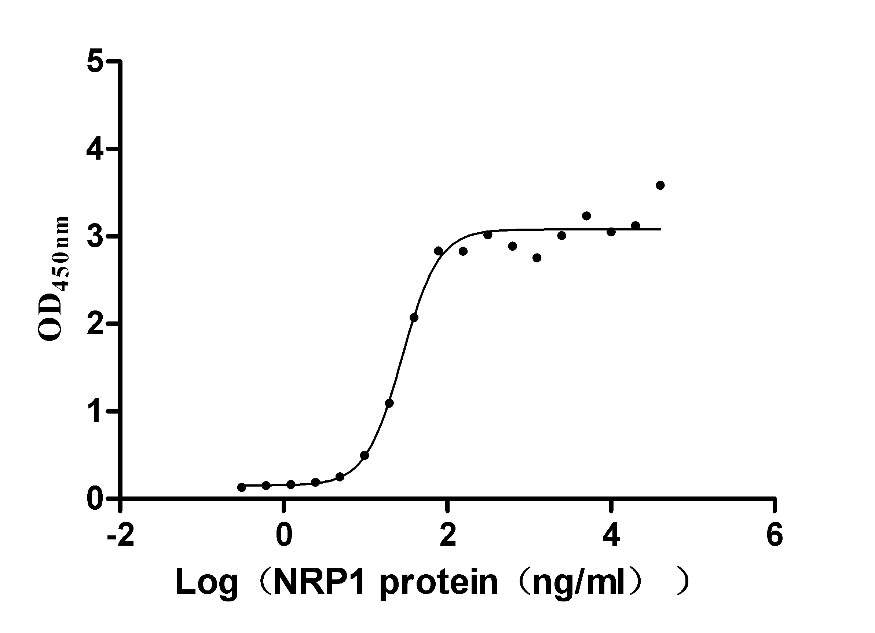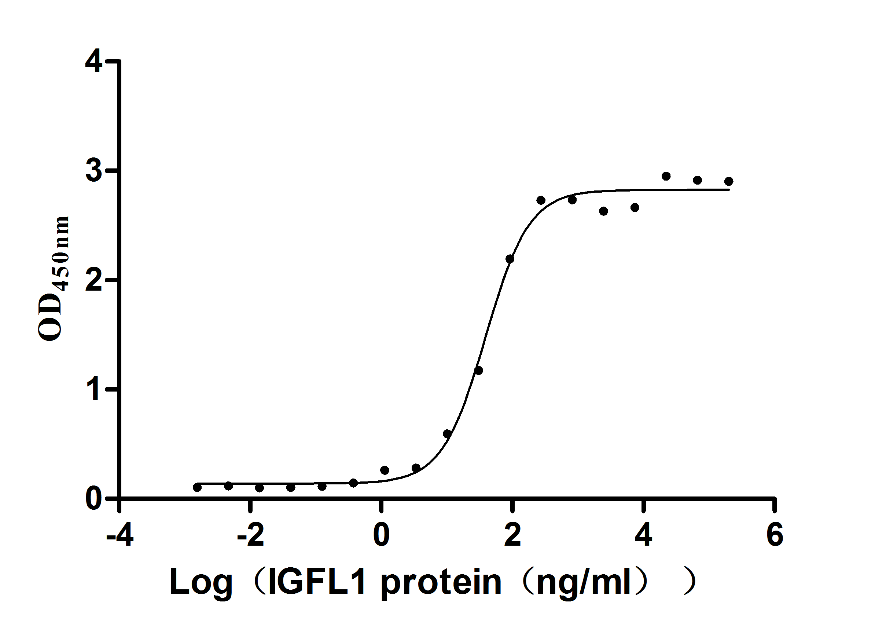Recombinant Mouse Ephrin-A5 (Efna5)
-
货号:CSB-YP007464MO
-
规格:
-
来源:Yeast
-
其他:
-
货号:CSB-EP007464MO
-
规格:
-
来源:E.coli
-
其他:
-
货号:CSB-EP007464MO-B
-
规格:
-
来源:E.coli
-
共轭:Avi-tag Biotinylated
E. coli biotin ligase (BirA) is highly specific in covalently attaching biotin to the 15 amino acid AviTag peptide. This recombinant protein was biotinylated in vivo by AviTag-BirA technology, which method is BriA catalyzes amide linkage between the biotin and the specific lysine of the AviTag.
-
其他:
-
货号:CSB-BP007464MO
-
规格:
-
来源:Baculovirus
-
其他:
-
货号:CSB-MP007464MO
-
规格:
-
来源:Mammalian cell
-
其他:
产品详情
-
纯度:>85% (SDS-PAGE)
-
基因名:
-
Uniprot No.:
-
别名:Efna5; Epl7; Eplg7; Lerk7Ephrin-A5; AL-1; EPH-related receptor tyrosine kinase ligand 7; LERK-7
-
种属:Mus musculus (Mouse)
-
蛋白长度:Full length protein
-
表达区域:21-203
-
氨基酸序列QDPGSKVVAD RYAVYWNSSN PRFQRGDYHI DVCINDYLDV FCPHYEDSVP EDKTERYVLY MVNFDGYSAC DHTSKGFKRW ECNRPHSPNG PLKFSEKFQL FTPFSLGFEF RPGREYFYIS SAIPDNGRRS CLKLKVFVRP TNSCMKTIGV HDRVFDVNDK VENSLEPADD TVHESAEPSR GEN
-
蛋白标签:Tag type will be determined during the manufacturing process.
The tag type will be determined during production process. If you have specified tag type, please tell us and we will develop the specified tag preferentially. -
产品提供形式:Lyophilized powder
Note: We will preferentially ship the format that we have in stock, however, if you have any special requirement for the format, please remark your requirement when placing the order, we will prepare according to your demand. -
复溶:We recommend that this vial be briefly centrifuged prior to opening to bring the contents to the bottom. Please reconstitute protein in deionized sterile water to a concentration of 0.1-1.0 mg/mL.We recommend to add 5-50% of glycerol (final concentration) and aliquot for long-term storage at -20℃/-80℃. Our default final concentration of glycerol is 50%. Customers could use it as reference.
-
储存条件:Store at -20°C/-80°C upon receipt, aliquoting is necessary for mutiple use. Avoid repeated freeze-thaw cycles.
-
保质期:The shelf life is related to many factors, storage state, buffer ingredients, storage temperature and the stability of the protein itself.
Generally, the shelf life of liquid form is 6 months at -20°C/-80°C. The shelf life of lyophilized form is 12 months at -20°C/-80°C. -
货期:Delivery time may differ from different purchasing way or location, please kindly consult your local distributors for specific delivery time.Note: All of our proteins are default shipped with normal blue ice packs, if you request to ship with dry ice, please communicate with us in advance and extra fees will be charged.
-
注意事项:Repeated freezing and thawing is not recommended. Store working aliquots at 4°C for up to one week.
-
Datasheet :Please contact us to get it.
靶点详情
-
功能:Cell surface GPI-bound ligand for Eph receptors, a family of receptor tyrosine kinases which are crucial for migration, repulsion and adhesion during neuronal, vascular and epithelial development. Binds promiscuously Eph receptors residing on adjacent cells, leading to contact-dependent bidirectional signaling into neighboring cells. The signaling pathway downstream of the receptor is referred to as forward signaling while the signaling pathway downstream of the ephrin ligand is referred to as reverse signaling. Induces compartmentalized signaling within a caveolae-like membrane microdomain when bound to the extracellular domain of its cognate receptor. This signaling event requires the activity of the Fyn tyrosine kinase. Activates the EPHA3 receptor to regulate cell-cell adhesion and cytoskeletal organization. With the receptor EPHA2 may regulate lens fiber cells shape and interactions and be important for lens transparency maintenance. May function actively to stimulate axon fasciculation. The interaction of EFNA5 with EPHA5 also mediates communication between pancreatic islet cells to regulate glucose-stimulated insulin secretion. Cognate/functional ligand for EPHA7, their interaction regulates brain development modulating cell-cell adhesion and repulsion.
-
基因功能参考文献:
- that Epha2 and Efna5 participate in the complex, global patterning of lens fiber cells that is necessary for maximal optical quality PMID: 29800803
- This study demonstrated for a role of ephrinA signaling for the selective targeting of serotonergic raphe nuclei. We show that EphA5 is differentially expressed across the different hindbrain raphe nuclei, and that this correlates with a different repulsive action of ephrinA on 5-HT axon growth. PMID: 28197551
- these results suggest that the basic helix-loop-helix transcription factorsbinding site in ECR1 is involved in the positive regulation of ephrin-A5 gene expression during the development of the mesencephalon. PMID: 28614915
- During urogenital development, different modes of Eph/Ephrin signaling occur at several sites with EphrinB2 and EphrinA5 acting in concert. PMID: 27344203
- dissociations of N-cadherin and adherens junctions in the associated interlocking domains may result in the formation of isolated globules and nuclear opacities in the ephrin-A5(-/-) mice. PMID: 26643403
- Overexpression of Ephrin-A5 in mice results in decreasing the size of progenitor pool through inducing apoptosis. PMID: 26674965
- Ephrin-A5 interacts with Ephrin-A4 to modulate neurogenesis and angiogenesis in a model of temporal lobe epilepsy. PMID: 25502292
- Data show the effects of genetic loss of ephrin-A5, Eph receptors EphA4, and EphA7 on the development of medulloblastoma tumors in the smoothened (Smo) transgenic mouse model. PMID: 26345456
- the unique cross-subclass interaction of EphB2 with ephrin A5 has evolved to function upstream of JNK signaling for the purpose of maintaining an adequate pool of progenitor cells to ensure proper closure of the optic fissure. PMID: 26839344
- Female mice lacking EFNA5 are subfertile, exhibit a compromised response to LH, and display abnormal ovarian histology after superovulation. PMID: 26672804
- NF-kappaB in NG2(+) cells promotes myoblast migration to the tips of myofibers through cell-cell contact through expression of ephrinA5 from NG2(+) cells PMID: 26777211
- The reduced nuclear size and diminished gene expression mirrors subtle changes in ephrin A5 expression evident in P1 and P4 enucleated neocortex, 11 and 8 days prior to natural eye opening, respectively. PMID: 26452243
- These data support the hypothesis that the retinocollicular projection is a superimposition of a number of individual two-dimensional topographic maps that originate from specific types of RGCs, require ephrin-A signaling. PMID: 25649160
- Ephrin A2 and Ephrin-A5 are important for the functional development of cutaneous innervation. PMID: 25243788
- ephrin A5 ligands imported by invading thalamic axons interact with EphA4-expressing radial glial cells. PMID: 25480914
- data show that ephrinA5 drives repellent interactions between temporal and nasal axons within the superior colliculus, and demonstrates for the first time that target-independent mechanisms play an essential role in retinocollicular map formation in vivo. PMID: 25451192
- multi-protein complex comprising ephrinA5, EphA7, and TNFR1 may constitute a platform for inducing caspase-dependent apoptotic cell death PMID: 23657875
- Ephrin-A5 has a critical role in postnatal lens fiber organization to maintain lens transparency PMID: 23401654
- Complementary expression of ephrin-A5 in hair cells and EphA4 receptor among spiral ganglion neuron populations controls the targeting of type I and type II afferent fibres to inner and outer hair cells, respectively. PMID: 23385583
- ephrin-A5 expression appears to be critical for proper development of central monoaminergic pathways and that its loss results in a number of neurodevelopmental abnormalities PMID: 22954718
- Ephrin-A5 is induced in reactive astrocytes in periinfarct cortex and is an inhibitor of axonal sprouting and motor recovery in stroke. PMID: 22837401
- In a growth cone collapse assay, mouse embryonic stem cell-derived spinal motor neurons respond to ephrin-A5, semaphorin(Sema)3f, and Sema3a in a concentration-dependent manner. PMID: 22279234
- Results demonstrated that the ephrinA5-EphA4/EphA5 system plays an important role in the direct pathway-dependent regulation of the SNr in cocaine responses and would provide valuable therapeutic targets of cocaine addiction. PMID: 21628570
- Our work shows that ephrinA5 protein is expressed in restrictive regions of the developing mouse brain PMID: 20738842
- EphA/ephrin-A signaling plays crucial roles in the establishment and/or maintenance of the brain vascular system, as an essential constituent of the adult neurogenic niche. PMID: 20474079
- Results indicate that on postnatal day 8 (P8), the dendrites in mutant animals exhibit more filopodia and are more branched than dendrites of wildtype cells; on P23, dendrites are still more branched, but possess fewer spines than wildtype cells. PMID: 19827157
- Optic nerve section in adult rat regulates the expression of EphA5 in the retina.EphA5 was expressed as an increasing naso-temporal gradient. By 1 month, expression was decreased resulting in a uniform expression across the naso-temporal axis. PMID: 11860487
- Involved in embryonic axon guidance of limbic thalamocortical projections; gene knockout results in "miswiring" of these pathways PMID: 12417660
- Ephrin A5 receptor in the thalamus and ephrin A5 in the cerebral cortex control intra-areal topographic mapping of thalamocortical axons. PMID: 12895420
- positional differences in axon terminal areas are eliminated with ephrin-A5 overexpression PMID: 15527895
- We conclude that ectopic expression of ephrin A5 in murine fibroblasts elevates oncogenic potential, including increased invasive behaviour, anchorage-independent growth, and morphological transformation. PMID: 17022942
- Ephrin-A5 enhances the motility of cortical neurons that is dependent on the activity of Src-family kinases; Ephrin-A5 further changes the adhesive properties of neurons by inducing the formation of cell aggregates. PMID: 17522309
- ephrin-A5 specifically regulates branch formation of thalamic axons, but does not affect target layer selection PMID: 18463505
- Results compare gene expression patterns in the somatosensory cortex of wild type and ephrinA5 deficient mice, which exhibit subtle, but highly reproducible alterations of thalamocortical projections and intrinsic cortical circuits. PMID: 18619851
- Results suggest that ephrin-A5 acts as an inhibitory flank that contributes to define the pathway of migrating interneurons. PMID: 18662335
- Ephrin-A5 and B1 localization and signaling in murine fibroblasts and tissues were examined. PMID: 18694724
- Analysis of the striatal patterning in ephrin A5/EphA4 mutant mice revealed the requirement of EphA4 signalling for the proper sorting of matrix and striosome neuronal populations in vivo. PMID: 18755772
- ephrin-A5 interacts with the EphA2 receptor to regulate the adherens junction complex, a key role in lens fiber cell shape and cell-cell interactions PMID: 18948590
- ephrinAs and more specifically ephrinA5, may be actors in the guidance of dopaminergic projections PMID: 19576892
显示更多
收起更多
-
亚细胞定位:Cell membrane; Lipid-anchor, GPI-anchor. Membrane, caveola; Lipid-anchor, GPI-anchor.
-
蛋白家族:Ephrin family
-
组织特异性:Expressed in myogenic progenitor cells.
-
数据库链接:
KEGG: mmu:13640
STRING: 10090.ENSMUSP00000076115
UniGene: Mm.401670
Most popular with customers
-
Recombinant Human Neuropilin-1 (NRP1) (Active)
Express system: Mammalian cell
Species: Homo sapiens (Human)
-
Recombinant Human IGF-like family receptor 1 (IGFLR1), partial (Active)
Express system: Mammalian cell
Species: Homo sapiens (Human)
-
Recombinant Human Claudin-6 (CLDN6)-VLPs (Active)
Express system: Mammalian cell
Species: Homo sapiens (Human)
-
Recombinant Human Cell adhesion molecule 1 (CADM1), partial (Active)
Express system: Mammalian cell
Species: Homo sapiens (Human)
-
Recombinant Human Myosin regulatory light polypeptide 9 (MYL9) (Active)
Express system: Yeast
Species: Homo sapiens (Human)
-
Recombinant Human C-C chemokine receptor type 9 (CCR9)-VLPs (Active)
Express system: Mammalian cell
Species: Homo sapiens (Human)
-
Recombinant Human C-C chemokine receptor type 5 (CCR5)-VLPs
Express system: Mammalian cell
Species: Homo sapiens (Human)




-AC1.jpg)














